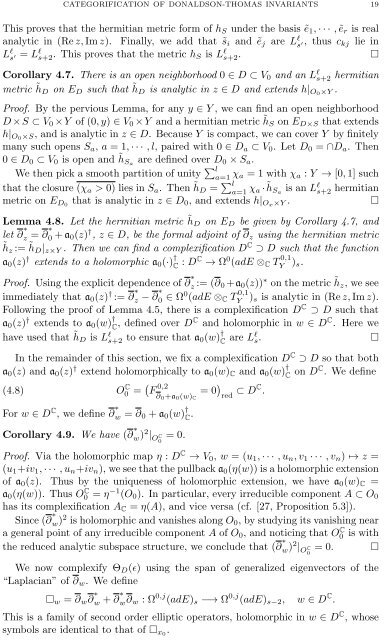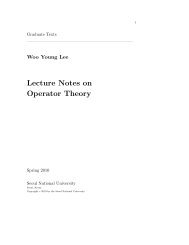Categorification of Donaldson-Thomas invariants via perverse ...
Categorification of Donaldson-Thomas invariants via perverse ...
Categorification of Donaldson-Thomas invariants via perverse ...
Create successful ePaper yourself
Turn your PDF publications into a flip-book with our unique Google optimized e-Paper software.
CATEGORIFICATION OF DONALDSON-THOMAS INVARIANTS 19This proves that the hermitian metric form <strong>of</strong> h S under the basis ẽ 1 , · · · , ẽ r is realanalytic in (Re z, Im z). Finally, we add that ˜s i and ẽ j are L l s ′, thus c kj lie inL l s ′ = Ll s+2. This proves that the metric h S is L l s+2. □Corollary 4.7. There is an open neighborhood 0 ∈ D ⊂ V 0 and an L l s+2 hermitianmetric ˜h D on E D such that ˜h D is analytic in z ∈ D and extends h| O0×Y .Pro<strong>of</strong>. By the pervious Lemma, for any y ∈ Y , we can find an open neighborhoodD ×S ⊂ V 0 ×Y <strong>of</strong> (0, y) ∈ V 0 ×Y and a hermitian metric ˜h S on E D×S that extendsh| O0×S, and is analytic in z ∈ D. Because Y is compact, we can cover Y by finitelymany such opens S a , a = 1, · · · , l, paired with 0 ∈ D a ⊂ V 0 . Let D 0 = ∩D a . Then0 ∈ D 0 ⊂ V 0 is open and ˜h Sa are defined over D 0 × S a .We then pick a smooth partition <strong>of</strong> unity ∑ la=1 χ a = 1 with χ a : Y → [0, 1] suchthat the closure (χ a > 0) lies in S a . Then ˜h D = ∑ la=1 χ a · ˜h Sa is an L l s+2 hermitianmetric on E D0 that is analytic in z ∈ D 0 , and extends h| Ox×Y . □Lemma 4.8. Let the hermitian metric ˜h D on E D be given by Corollary 4.7, andlet ∂ ∗ z = ∂ ∗ 0 + a 0 (z) † , z ∈ D, be the formal adjoint <strong>of</strong> ∂ z using the hermitian metric˜h z := ˜h D | z×Y . Then we can find a complexification D C ⊃ D such that the functiona 0 (z) † extends to a holomorphic a 0 (·) † C : DC → Ω 0 (adE ⊗ C T 0,1Y ) s.Pro<strong>of</strong>. Using the explicit dependence <strong>of</strong> ∂ ∗ z := (∂ 0 +a 0 (z)) ∗ on the metric ˜h z , we seeimmediately that a 0 (z) † := ∂ ∗ z − ∂ ∗ 0 ∈ Ω 0 (adE ⊗ C T 0,1Y) s is analytic in (Re z, Im z).Following the pro<strong>of</strong> <strong>of</strong> Lemma 4.5, there is a complexification D C ⊃ D such thata 0 (z) † extends to a 0 (w) † C , defined over DC and holomorphic in w ∈ D C . Here wehave used that ˜h D is L l s+2 to ensure that a 0 (w) † C are Ll s.□In the remainder <strong>of</strong> this section, we fix a complexification D C ⊃ D so that botha 0 (z) and a 0 (z) † extend holomorphically to a 0 (w) C and a 0 (w) † C on DC . We define(4.8) O C 0 = ( F 0,2∂ 0+a 0(w) C= 0 ) red ⊂ DC .For w ∈ D C , we define ∂ ∗ w = ∂ 0 + a 0 (w) † C .Corollary 4.9. We have (∂ ∗ w) 2 | O C0= 0.Pro<strong>of</strong>. Via the holomorphic map η : D C → V 0 , w = (u 1 , · · · , u n , v 1 · · · , v n ) ↦→ z =(u 1 +iv 1 , · · · , u n +iv n ), we see that the pullback a 0 (η(w)) is a holomorphic extension<strong>of</strong> a 0 (z). Thus by the uniqueness <strong>of</strong> holomorphic extension, we have a 0 (w) C =a 0 (η(w)). Thus O C 0 = η −1 (O 0 ). In particular, every irreducible component A ⊂ O 0has its complexification A C = η(A), and vice versa (cf. [27, Proposition 5.3]).Since (∂ ∗ w) 2 is holomorphic and vanishes along O 0 , by studying its vanishing neara general point <strong>of</strong> any irreducible component A <strong>of</strong> O 0 , and noticing that O C 0 is withthe reduced analytic subspace structure, we conclude that (∂ ∗ w) 2 | O C0= 0. □We now complexify Θ D (ɛ) using the span <strong>of</strong> generalized eigenvectors <strong>of</strong> the“Laplacian” <strong>of</strong> ∂ w . We define□ w = ∂ w ∂ ∗ w + ∂ ∗ w∂ w : Ω 0,j (adE) s −→ Ω 0,j (adE) s−2 , w ∈ D C .This is a family <strong>of</strong> second order elliptic operators, holomorphic in w ∈ D C , whosesymbols are identical to that <strong>of</strong> □ x0 .













